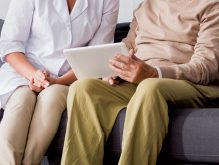October is National Breast Cancer Awareness Month. This is a very personal issue with me because I am a 7-year survivor of breast cancer.
October is also the month of my cancer diagnosis. Every anniversary of my diagnosis is a reason to celebrate. Each year that I am able to walk in the Survivors’ Walk at Relay for Life is a fresh victory.
Many great strides have been made in the fight against breast cancer—in both the search for better treatment and more knowledge of how to have early diagnosis of the disease. Women and men alike have struggled with this dreaded diagnosis.
Key Statistics
Breast cancer is the most common cancer among American women, except for skin cancers. About one in eight US women will develop invasive breast cancer.
The American Cancer Society estimates for breast cancer in the US for 2013:
• About 232,340 new cases of invasive breast cancer will be diagnosed in women
• About 64,640 new cases of carcinoma in situ (CIS) will be diagnosed (CIS is non-invasive & is the earliest form of breast cancer)
• About 39,620 women will die from breast cancer
After increasing for more than 20 years, female breast cancer incidence rates began decreasing in 2000, then dropped by about 7% from 2002 to 2003. This significant decrease was attributed to the decline in the use of hormone therapy after menopause that occurred after the results of the Women’s Health Initiative—a study linking the use of hormone therapy to an increased risk of breast cancer and heart diseases—were published in 2002.
Breast cancer is the 2nd leading cause of cancer death in women, exceeded only by lung cancer. Through earlier detection and increased awareness, as well as improved treatment, death rates from breast cancer have been declining since about 1989.
Risk Factors
Aging: Risk of breast cancer increases as you get older. About one out of eight invasive breast cancers are found in women younger than 45, while about two of three invasive breast cancers are found in women age 55 or older.
Genetic: About 5-10% of cases arc thought to be hereditary.
Family history: Having a mother, sister, or daughter with breast cancer doubles your risk. Having two relatives with breast cancer triples it.
Personal history: A woman with cancer in one breast has a 3-4-fold increased risk of developing a new cancer in the same or other breast.
Race & ethnicity: White women are slightly more likely to develop breast cancer than African-Ameri-cans, but African-Americans are more likely to die of this cancer.
Having children: Women with no children or who had their first child after age 30 have a slightly increased risk.
Birth control: Women using birth control pills have a slightly greater risk. This risk seems to go back to normal over time once the pills are stopped.
Hormone therapy after menopause: Hormone therapy with estrogen combined with progesterone increases the risk and also increases the chances of dying with breast cancer. The risk seems to return to that of the general population within five years of stopping hormone therapy.
Use of alcohol: Those who have two to five drinks daily have about 1 Zi times the risk of women who don’t drink alcohol.
Overweight/obese: Being overweight or obese after menopause increases breast cancer risk.
Physical activity: Evidence is growing that physical activity in the form of exercise reduces breast cancer risk. In one study, as little as 1.25 to 2.5 hours per week of brisk walking reduced risk by 18%.
Check Also
Trusted Homecare Agency: Serving Veterans with Free Supplemental Home Healthcare
When it comes to healthcare, veterans deserve the best care possible. For veterans seeking in-home …
 South Florida Health and Wellness Magazine Health and Wellness Articles
South Florida Health and Wellness Magazine Health and Wellness Articles




